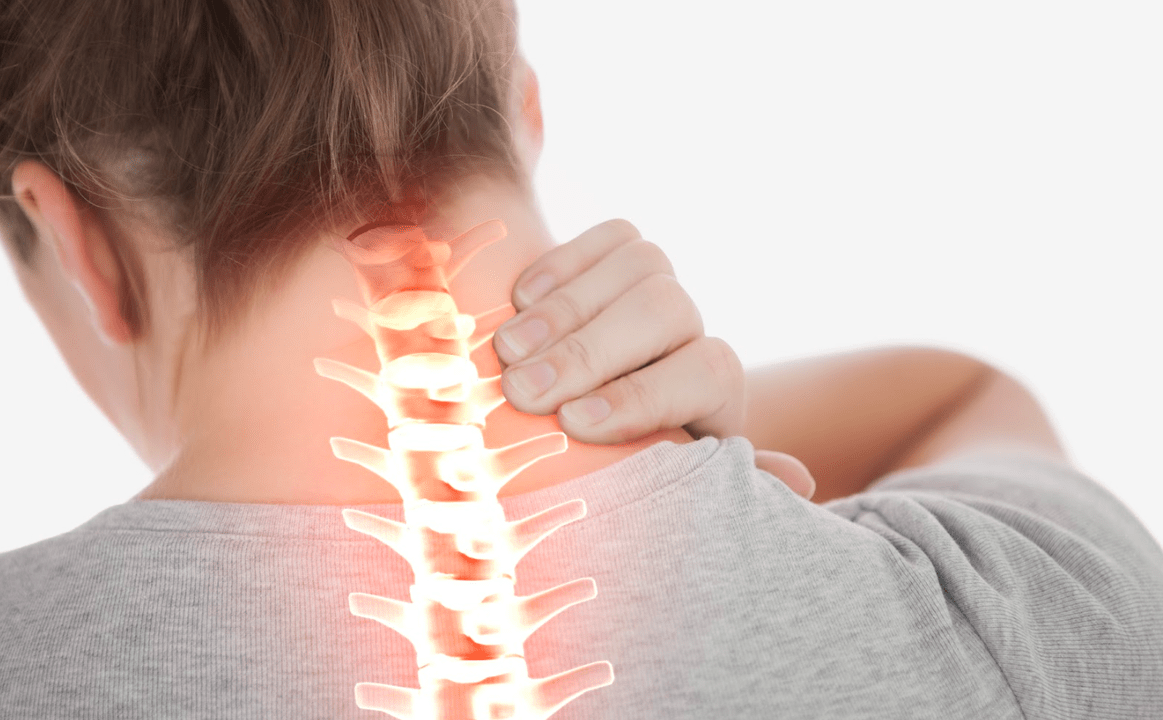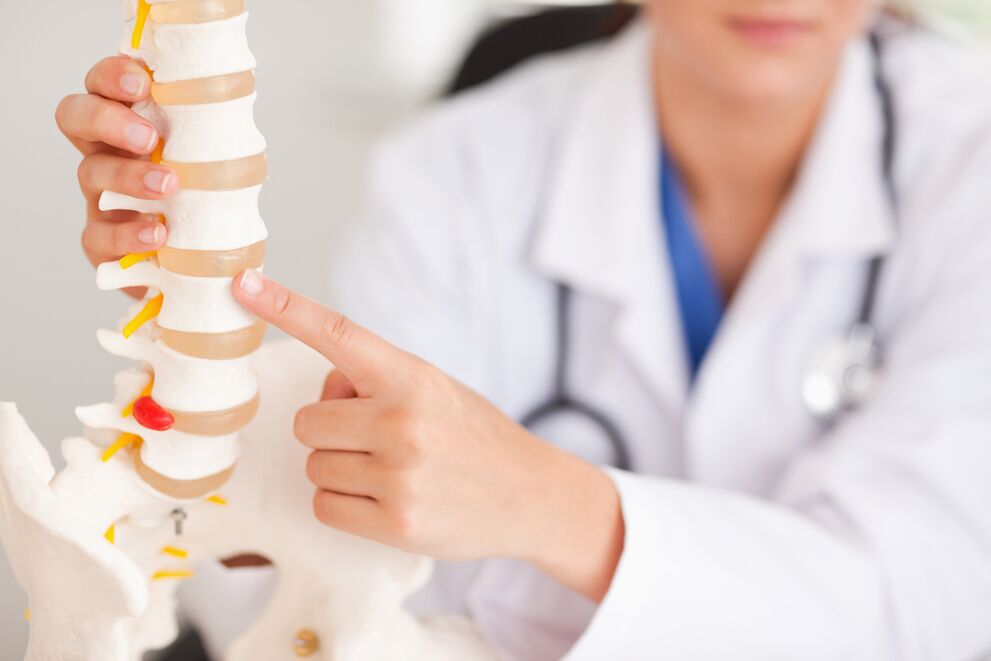Osteochondrosis is a degenerative destructive spine lesion, which includes the defeat of vertebral bodies, articulated apparatus, ligament apparatus and interverters. This disease is even common in all countries - from 45 to 85% of the population suffers from this disease. The beginning of osteochondrosis occurs in patients over 30-35 years, however, cases of the earlier start of the disease are known. Men and women get sick of approximately the same frequency.
Causes

There is no unique cause of osteochondrose development. There are a large number of predisposing causal factors. The main ones are as follows:
- Back injuries (breakdowns, bruises, dislocations);
- Hereditary predisposition;
- Foot disease that cause spine overload - involves flat legs, different foot deformations, valgus foot deformation;
- Wearing close and unpleasant shoes for a long time (also causes the overload of spine);
- Excess weight and obesity;
- Age-relefined changes;
- Sedentary lifestyle;
- Athletes who suddenly abandon training and teaching;
- Metabolic disorders;
- Spinal curvature (cyfose, lordosis, scoliosis);
- Professional characteristics - lifting weight, frequent turns and body jerks, work in an unpleasant position of the body;
- Frequent and extended hypothermia;
- Stress;
- Specific climate, both at the site of residence and in the workplace - low air temperatures and high moisture.
When exposed to one or more causal factors, the development of the disease begins. It is common to divide into four main phases:
- First phase. There is a reduction in the amount of moisture in the core of the intervertebral disk, it becomes more flat, distance between vertebral decreases. The cartilage is covered with smaller cracks.
- Second phase. Due to the reduction of the distance between vertebral, muscles and ligamento apparatus of vertebrae appear. This leads to the pathological mobility of the orthebral bodies, on their displacements.
- Third phase. Due to progressive processes in the spine, the grinding (protrusion) of interfood drives occurs, it is subclusion of vertebral disks.
- Fourth phase. Between vertebra, vertebrae, bone spikes (osteophytes) that are directed to eliminate vertebral mobility, dislocation prevention. Over time, they are so much so much that affected spines are completely lost mobility. In this case, there is a trauma of blood vessels and nerves passing near the vertebrae and leaving the spinal column.
In the first and last phases of the diseases of the clinical manifestations (pain), the patient does not.
Classification
There is a lot of classification of osteochondrose. Each doctor chooses the most reception for themselves. The following classifications are most often used:
Classification of defeat spine:
- Cervical osteochondrose;
- Thoracic osteochondrose;
- Lumbar osteochondrosis;
- Osteochondrose crowning;
- Extensive (usual) osteochondrosis - affects 2 or more spine.
Classification by degree change in the intervertebral disk (radiological phases):
- 0 phase - There is no disk change;
- 1. phase - minor changes, including maximum internal tears;
- 2 phases - severe changes on disk with the maintenance of the outer surface;
- Phase 3 - The entire disk is fully affected (cracks spreading to the outer surface, squeezing the disk below the vertebral body, etc. ).
Classification on clinical events and degree of weakened spine function:
- 1. Phase - The functioning of the spine is not changed, the patient feels mild pain in the lesion;
- 2 phases - The functioning of the spine is disturbed (subluxuses ortebral bodies, the disk protrusion, nerve pinch), pain at the scope of destruction intensively;
- Phase 3 - The spine is deformed, consists of the pounds of intervertebral disks, significant pain;
- Stage 4 - The patient is difficult to move, the mobility of the spine decreases, hurts during the lower movement. The patient is given by disability.
Symptoms of osteochondrose

The symptoms of osteochondrosis depend on the area of spine damage and on the degree of disorders that appear in it.
For an expanded clinical picture of osteochondrosis of cervix, are characteristic:
- Violence of vision sharpness;
- Dizziness;
- Tinnitus;
- Flashing "flies" in front of the eyes and the appearance of colored stains;
- Hearing loss;
- Headache in the tense, temporal and parietal region, intensification when moving in the cervix spine;
- Loss of consciousness;
- Snoring;
- Hoarsely voice or his weakening;
- Armeness and loss of sensitivity on the skin, neck and hand;
- Dental destruction;
- Blood pressure board.
For osteochondrosis of the thoracic spine, the following symptoms are characteristic:
- Heartache, lasting long, painful or pressing, often sharp, sewing, sharp, patients can show a certain pain;
- Skin stiffness in chest, abdomen and back;
- The pain in the spine, especially between the spatula, strongly expressed;
- Pain when lifting their hands;
- Pain with a sharp and deep breath, and later join when exhaled;
- Pain, discomfort and difficulty during the body slope in any direction.
The following symptoms are characteristic of osteochondrose of lumbar and sacral spine:
- Pastness in the area of lumbar and sacral spine (lumbar), which can give in one or both legs, intensifying with any movement of the spine in the affected area;
- Foot freeze at comfortable temperature for other parts of the body;
- Almost constant tension in the back muscles, especially lumbar regions;
- A feeling of stiffness, crawling goosebumps and tingling on the skin of the leg and buttocks;
- Varicose veins on their feet;
- Violation of potential in men;
- Increased sweat;
- Pale skin on their feet;
- Incorrect menstruation in women.
With prolonged and neglected osteochondrose, when the bracket is affected with each other, the patient concerned only the impossible movement in a particular spine, hurts, completely reduces or completely decreases or leaves.
Diagnostics
First of all, the doctor implements the survey and testing the patient, establishing a preliminary diagnosis. Additional test methods are assigned to confirmation. With osteochondrose, they are only instrumental, because the laboratory (tests) will not show any confirmation of change.
The main diagnostic methods include the following:
- X -Ray examination. Allows you to determine the degree of damage to vertebral, their locations, bone formations. Indirect methods you can determine the state of bone channels and interface dyss;
- Computer Tomography (CT). It allows you to determine the condition of interfood drives, their structure and shape, deformation of vertebral and compression of nerve endings and roots;
- Magnetic resonance imaging (MRI). It allows you to determine minor violations of the spine and prescribes in cases when controversial issues remain post CT;
- Ultrasonic process. Allows you to identify the degree of blood flow in containers that feed the spinal cord and other organs;
- Myelography. The method of radiographs of spine using contrast. Allows you to identify interverter hernias.
Healing osteochondrose
Conservative treatment
In the treatment of osteochondrose, conservative treatment methods are primarily used. In this case, access to each patient should be individual and complex. Conservative treatment methods can be divided into 4 main groups:
- Medication treatment;
- Physiotherapy;
- Spa treatment;
- Diet (basics of proper nutrition).
Treatment of drugs Osteochondrosis

The drugs used in the treatment of osteochondrose must be used in exigh times. Contribute to reducing symptoms, and also affect some causal factors in disease development. Main groups of drugs used in the treatment of osteochondrose:
- NSAID. Non-steroidal anti-inflammatory drugs have anesthetic, anti-Irrorous effects, and also reduce the elevated temperature of the affected tissues of spine and its structures. With pronounced symptoms, the first days of deterioration of the disease are prescribed in the form of injections. The frequency of use is 1-2 times a day. After that, they cross the forms of drug pills with a 10-30 day treatment rate, if necessary. The incidence of reception is from 1 to 4 times a day. Also, together with tablets and injections, the fats or creams are displayed, which are on the skin in the spine area 1-3 times a day.
- Musorelaxans. Preparations of this group make up a large load capacity with increased muscle tone, relaxing transversely broken muscle fiber and facilitating the patient's condition. On average, the course of treatment is about 1 month. With heavy symptoms, treatment begins with drug injection. Dosage must start with minimal, gradually increasing until therapeutic effect is achieved, after which it is also gradually reduced to complete the cancellation.
A few more groups are used as additional drugs:
- Vitamins. Accelerate tissue restoration processes, normalizing nervous conductivity, accelerate metabolism, etc. Almost always these abyss for osteochondrose are prescribed in the form of injections, courses for 10 days. These are vitamins B1, B2, B6, E.
- Blood preparations. These drugs normalize blood flow in veins and arteries, return the muscle tone of blood vessels and return the metabolism. Tablet forms of release are most commonly used. The duration of treatment with this agent is from 1 to 3 months. Also, in extreme cases, the injection of medicines is possible for the first 5-10 days, with a subsequent transition on the tablets.
- Glucocorticosteroids. They have anti -infalmatory, decongestant effects, improve the work of NSAIDs and muscle relaxants. Depending on the severity of the patient's condition, they are prescribed in the form of injections intramuscularly or intra-no. Or in the form of oral application tablets. The course of treatment is selected individually, from a few days to a few weeks. The abolition of the drug should take place by gradual dosing reduction.
- Biogenic stimulants. Accelerate metabolism, encourage tissue restoration, reduce inflammation and swelling of tissues and more. It is most often used in the form of injection and slightly less common in pill or other forms for oral administration. The course of treatment can range from 1 week to 2-3 months, depending on the severity of the disease.
Physiotherapy treatment of osteochondrose
Physiotherapy measures, combined with medicines, allow you to accelerate the recovery process, and also expand the period of remission when used beyond deterioration. There are a lot of physiotherapy methods and most of them are practiced in the treatment of osteochondrose:
- Electrophoresis. Depending on the medications used in this procedure, an analgesic effect is obtained. Metabolism has improved the normalization of blood flow in affected tissues.
- Acupuncture (acupuncture). With the help of special best needles and their effects on the active points located on the patient's skin, an analgesic effect is achieved, recovery and metabolic processes are encouraged, and inflammation decreases.
- Magnetotherapy. Reduces pain, swelling and inflammation of tissues, accelerates nervous conductivity, normalizes metabolic processes
- Hand therapy. Mobility is renewed in spine joints, pain syndrome has been reduced.
- Massage. Normalize the muscular tone, eliminates back pain, renews nervous conductivity.
- Exercise therapy. Restoring the mobility of the spine, reducing pain, restoring the usual lifestyle, strengthening the muscle frame back, relaxing the back muscle, accelerating metabolism.
- Towing the spine. The mobility of the spine is renewed, prevents the progression of the disease and develop complications and anesthesia.
- Laser therapy. Improves blood supply, encourages tissue regeneration, reduces pain and inflammation, reduces the swelling of the spine.
- Thermotherapy. Anesthetic effect, normalization of blood flow and lymph through blood vessels, reduction in inflammation in tissues, accelerating the reconstruction of cartilage.
- Mudreing (peloid therapy). Reduces the pain in the spine, reduces muscle cramp, slightly reduces the inflammation processes, improves blood and metabolism supply.
One patient can be prescribed for 1 physiotherapy event and their complex. It depends on the weight of the osteochondrose process and on the accompanying pathologies. The duration of treatment mode is on average 10-15 days. It is recommended to repeat 3-4 times during the year. Therefore, it is possible to reduce the frequency of deterioration and the rate of osteochondrose progress several times.























